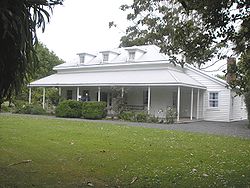
Te Waimate mission
Encyclopedia
The Waimate Mission established one of the earliest settlements in New Zealand
, at Waimate North
in the Bay of Islands
 At the instigation of Samuel Marsden
At the instigation of Samuel Marsden
, a model farming village for Māori was constructed at Te Waimate by the Church Missionary Society. Land was bought from the Ngapuhi
tribe following the Girls War of 1830.
The village comprised three wooden houses for missionary families, a flour mill, printery, carpenters' shop, brickworks, blacksmith, school and of course church. Marsden hoped Māori would be educated into European culture while making the mission station a paying proposition by producing goods for sale to European shipping and other Māori through the Stone Store
at Kerikeri
.
 The attempt to impose European culture on Maori in a controlled fashion where those being taught also formed the labour, failed to attract many Māori and the station was gradually run down, some buildings being converted to teach theology as St John’s College (New Zealand), although this moved to Auckland in 1844. The mission station was occupied by British soldiers during the The Flagstaff War of 1845, (casualties of the Battle of Ohaeawai
The attempt to impose European culture on Maori in a controlled fashion where those being taught also formed the labour, failed to attract many Māori and the station was gradually run down, some buildings being converted to teach theology as St John’s College (New Zealand), although this moved to Auckland in 1844. The mission station was occupied by British soldiers during the The Flagstaff War of 1845, (casualties of the Battle of Ohaeawai
were buried there). After the war the buildings were subsequently put up for sale.
Today the only remnant on the site is the house originally occupied by George Clarke, which is preserved by the New Zealand Historic Places Trust
as a museum. One of the other houses survives at the Butler Point Whaling Museum
.
New Zealand
New Zealand is an island country in the south-western Pacific Ocean comprising two main landmasses and numerous smaller islands. The country is situated some east of Australia across the Tasman Sea, and roughly south of the Pacific island nations of New Caledonia, Fiji, and Tonga...
, at Waimate North
Waimate North
Waimate North is a small settlement in Northland, New Zealand. It is situated between Kerikeri and Lake Omapere, west of the Bay of Islands.Okuratope Pa was situated here and was the home to chief Te Hotete of the Ngai Tawake hapu in the late 18th-early 19th centuries...
in the Bay of Islands
Bay of Islands
The Bay of Islands is an area in the Northland Region of the North Island of New Zealand. Located 60 km north-west of Whangarei, it is close to the northern tip of the country....

Samuel Marsden
Samuel Marsden was an English born Anglican cleric and a prominent member of the Church Missionary Society, believed to have introduced Christianity to New Zealand...
, a model farming village for Māori was constructed at Te Waimate by the Church Missionary Society. Land was bought from the Ngapuhi
Ngapuhi
Ngāpuhi is a Māori iwi located in the Northland region of New Zealand, and centred in the Hokianga, the Bay of Islands and Whāngārei.Ngāpuhi has the largest affiliation of any New Zealand iwi, with 122,214 people registered , and formed from 150 hapu, with 55 marae.-Foundations:The founding...
tribe following the Girls War of 1830.
The village comprised three wooden houses for missionary families, a flour mill, printery, carpenters' shop, brickworks, blacksmith, school and of course church. Marsden hoped Māori would be educated into European culture while making the mission station a paying proposition by producing goods for sale to European shipping and other Māori through the Stone Store
Stone Store
The Stone Store at Kerikeri in the Bay of Islands is New Zealand’s oldest surviving stone building.Part of the first Church Missionary Society station in New Zealand, the store was designed by John Hobbs to replace an earlier wooden store house. The Stone Store was erected between 1832 and 1836 by...
at Kerikeri
Kerikeri
Kerikeri, the largest town in the Northland Region of New Zealand, is a popular tourist destination about three hours drive north of Auckland, and 80 km north of Whangarei...
.

Battle of Ohaeawai
The Battle of Ohaeawai was fought between British forces and local Māori during the Flagstaff War in July 1845 at Ohaeawai in the North Island of New Zealand...
were buried there). After the war the buildings were subsequently put up for sale.
Today the only remnant on the site is the house originally occupied by George Clarke, which is preserved by the New Zealand Historic Places Trust
New Zealand Historic Places Trust
The New Zealand Historic Places Trust is a non-profit trust that advocates for the protection of ancestral sites and heritage buildings in New Zealand...
as a museum. One of the other houses survives at the Butler Point Whaling Museum
Butler Point Whaling Museum
Butler Point Whaling Museum is located at Hihi, near Mangonui in New Zealand’s Doubtless Bay, a centre for whaling fleets in the 1820s-1850s....
.

